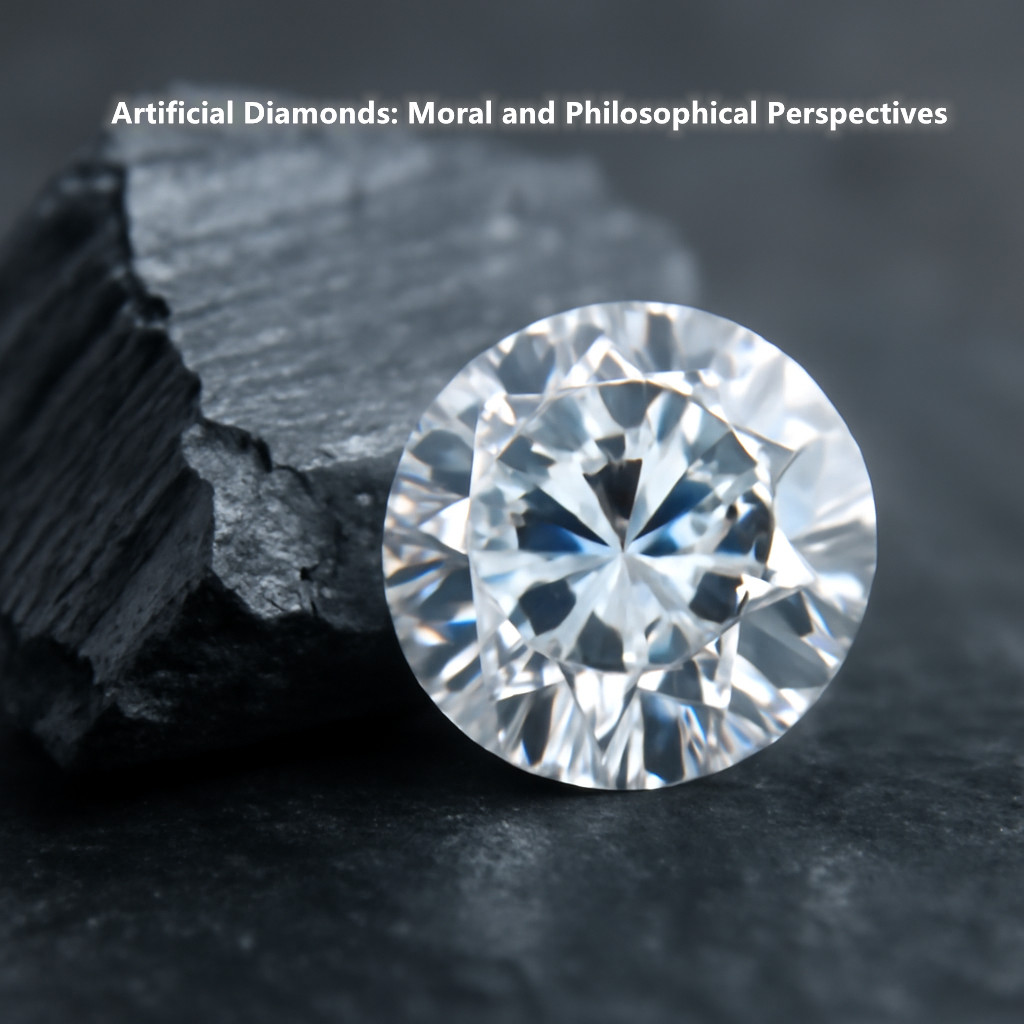
Artificial Diamonds: A Reflection on the Moral and Philosophical Dimensions
Diamonds have long held a place of prestige in human culture. Their enduring qualities—clarity, strength, and rare beauty—have made them symbols of love, wealth, and eternity. The tradition of gifting diamonds, especially in the form of engagement rings, has become so ingrained in many societies that it's often seen as a fundamental expression of romantic commitment. But with the advent of lab-grown diamonds, these age-old associations are being called into question. Are they still valid? Can a diamond that is not mined from the earth truly hold the same symbolic weight as one that has been extracted from the depths of the planet?
In this discussion, we will examine whether artificial diamonds—those cultivated in laboratories—can affect the traditional symbolic meanings of diamonds. We will explore the philosophical and ethical implications of these man-made stones, and consider whether their presence as a "substitute" in emotional and social contexts diminishes or enhances the meaning they hold.
The Traditional Symbolism of Diamonds
For centuries, diamonds have been woven into the fabric of human emotion and society. The diamond has come to represent various profound concepts, from love and devotion to wealth and eternal commitment. This symbolism has evolved over time, largely influenced by marketing and societal expectations, yet it remains firmly rooted in cultural norms.
Love and Commitment: Diamonds have long been associated with romantic love, especially through the custom of giving diamond engagement rings. The tradition, popularized in the 20th century by companies like De Beers, has elevated diamonds to the status of the ultimate symbol of commitment. A diamond ring signifies not just love but the promise of eternity. The idea of giving a diamond ring as a token of love connects the purity and rarity of the diamond with the purity and rarity of one's feelings. The common phrase "a diamond is forever" captures this sentiment, highlighting that the love it represents is also meant to be unbreakable and everlasting.
Wealth and Prestige: Diamonds have also symbolized wealth and social status. Historically, they were worn by royalty and the elite to demonstrate power and superiority. The rarity and expense of diamonds have made them coveted symbols of wealth. Even today, owning a diamond, particularly one that is large or flawless, is often seen as a marker of affluence and success. This association with wealth ties into the idea of exclusivity, where diamonds are seen as a luxury reserved for those who can afford them.
Eternity: One of the most powerful symbolic meanings of diamonds is their representation of eternity. This stems from the diamond's durability—its physical hardness makes it one of the most enduring substances on Earth. The metaphorical connection to eternity is perhaps most famously reflected in engagement rings, where the diamond is intended to symbolize an eternal bond, a love that will last beyond the temporal. The idea that a diamond can endure forever mirrors the hope for a relationship to endure the challenges of life.
The Emergence of Lab-Grown Diamonds: A New Paradigm?
In recent years, lab-grown diamonds have emerged as a legitimate alternative to mined diamonds. These diamonds, produced through chemical vapor deposition (CVD) or high-pressure high-temperature (HPHT) methods, have the same physical, chemical, and optical properties as natural diamonds. However, unlike their natural counterparts, lab-grown diamonds are created in controlled environments within a few weeks or months, rather than taking millions of years to form beneath the Earth's surface.
The availability of lab-grown diamonds has introduced a new dynamic into the diamond industry. They are often marketed as more affordable and ethically sourced alternatives to mined diamonds, which are frequently associated with environmental damage and human rights abuses. The question now arises: Can these lab-grown diamonds truly hold the same emotional and symbolic weight as their natural counterparts? Are they a valid replacement for diamonds, or do they represent something different altogether?

Emotional and Philosophical Dimensions of Lab-Grown Diamonds
Love and Commitment Revisited: One of the most profound emotional connections to diamonds is their role in representing love. When a person gives a diamond ring to their partner, they are often conveying more than just an object of value; they are expressing their deepest feelings and intentions. The traditional diamond's symbolism lies in its rarity, its long journey to reach its final form, and the notion that it is a treasure that is meant to last forever.
Lab-grown diamonds, however, challenge these assumptions. They are not rare in the same way as mined diamonds, and their creation is not a product of nature's slow process but of human ingenuity. Some might argue that a lab-grown diamond, because it can be mass-produced and is less rare, may lack the same "sacred" significance as a mined diamond. Others, however, might see the fact that a diamond's beauty can now be reproduced more efficiently as a triumph of human progress—perhaps reflecting a new kind of love that is not bound by the constraints of tradition.
Wealth and Prestige in the Age of Artificial Diamonds: Lab-grown diamonds are considerably more affordable than mined diamonds, which raises an important question: does the reduced cost diminish their symbolic association with wealth and social status? Traditionally, owning a large, flawless diamond has been a symbol of financial success and high social standing. But if lab-grown diamonds become more commonplace, could the idea of using diamonds as a status symbol lose its meaning?
Some would argue that diamonds, whether mined or lab-grown, will always carry an inherent value based on their beauty and craftsmanship, regardless of how they are sourced. Others might contend that lab-grown diamonds, because they are cheaper and more accessible, will no longer function as a symbol of exclusivity, and thus may lose their role as a marker of prestige.
Eternity and the Passage of Time: The symbolism of eternity that diamonds represent is tied not only to their physical durability but also to their age-old connection to the earth. The idea that a diamond takes millions of years to form adds to its mystique and sense of permanence. In contrast, lab-grown diamonds are created in a matter of weeks or months, which may make them feel more transient or less tied to the concept of eternity.
This raises an interesting philosophical question: does the passage of time matter to the symbolism of eternity? The diamond's connection to the infinite is not merely a function of its physical properties but of its narrative. A mined diamond’s story is one of geological time, while a lab-grown diamond’s story is one of human craftsmanship and innovation. Which, then, is the more "eternal" symbol: the one that is shaped by nature’s slow, deliberate hand, or the one that is shaped by human intention and progress?
Ethical Considerations: The Role of Artificial Diamonds in Society
Beyond the emotional and symbolic dimensions, the rise of lab-grown diamonds offers a new opportunity for ethical reflection. One of the major criticisms of the traditional diamond industry is its association with environmental destruction and exploitation of workers in developing countries. The mining of diamonds often involves significant environmental damage, and the "blood diamond" trade has raised concerns about human rights violations in countries where diamonds are mined under brutal conditions.
Lab-grown diamonds, in contrast, offer a cleaner alternative. Their production is generally more environmentally friendly, and they are not associated with the same ethical concerns as mined diamonds. For many, this makes lab-grown diamonds an appealing option, both from a moral and practical standpoint. But does this ethical advantage affect their symbolic value? In other words, do we place more importance on the moral qualities of a diamond when choosing it as a symbol of love, wealth, or eternity?
A New Tradition?
The arrival of lab-grown diamonds challenges the established meanings and values attached to diamonds. However, this does not necessarily mean that lab-grown diamonds are devoid of symbolic significance. In fact, they may represent a new paradigm in the way we think about love, wealth, and eternity.
Rather than viewing lab-grown diamonds as a "substitute" for mined diamonds, it might be more accurate to view them as a new iteration of the diamond's symbolic potential—one that reflects our evolving values, ethics, and perceptions of beauty. As we continue to grapple with questions of sustainability, ethical production, and human ingenuity, lab-grown diamonds may offer a way to preserve the emotional and philosophical meanings of diamonds while adapting to the changing times.
Ultimately, whether natural or lab-grown, the diamond—at least in the eyes of those who value it—will continue to represent the timeless quest for something precious, lasting, and beautiful. Perhaps it is not the method of its creation that defines its worth, but the meaning we choose to assign to it.











